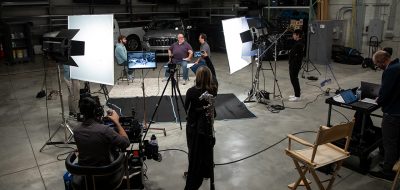On Sunday, December 12, 2018, we held a seminar on the use of video in the workplace, with Ikue Morishita, editor-in-chief of the monthly magazine “Public Relations Conference”, as moderator. We invited Mr. Nobuyuki Yotsuya, from the Technology Architecture & Service Management Department of the Operations & Technology Division of McDonald’s Japan (as of December 12, 2018), to talk about how the company uses video.
In this article, we will introduce the content of the talk given by McDonald’s Japan.
## The number of employees, including franchise owners and crew, is approximately 140,000
McDonald’s Japan not only operates directly managed stores, but also has many stores that are run under a franchise system, and the number of employees, including franchise owners and crew (including part-time employees), is approximately 140,000. The challenge for the company was how to thoroughly implement strategies, motivate, and engage these employees.
The background to the strengthening of internal communication was that McDonald’s Japan had temporarily fallen into poor performance due to various problems, and for several years they had been implementing a policy called “Always On”, in which new products were released every three weeks.
In addition, there were two issues that were unique to McDonald’s Japan crew members.
Firstly, the majority of McDonald’s Japan crew members are students, so when they graduate they leave the company, and around 70,000 crew members change each year. Secondly, in recent years the proportion of foreign crew members has increased, and while they generally have no problem communicating in spoken Japanese, many of them have difficulty reading and writing, so it is difficult for them to understand manuals that contain many kanji characters.
## Focusing on digital communication
In order to solve these issues, McDonald’s Japan took thorough measures to deliver information to employees using appropriate information vehicles (media). Specifically, they prepared information vehicles such as paper, smartphones, and tablets, but the main focus was on digital communication.
They set up an internal portal site for employees that could be viewed on smartphones and tablets, and they delivered monthly management messages and monthly sales performance announcements from the president in video format every month. Mr. Yotsuya stated on stage that the videos were effective because “information that would not be read if it was in paper form was read in its entirety, and information was communicated effectively”. He also stated that as a secondary effect, “the risk of information leaks was reduced because the use of videos eliminated the external leakage of sales results that had occurred when using paper media and presentation software”.
In addition, videos were made of how to cook hamburgers, how to maintain and clean cooking utensils, etc., and these could be referred to using tablets in the kitchen area. This made it possible to quickly convey information to busy employees in their limited time. It also made it possible for foreign crew members to understand the manual visually.
## It helped to strengthen the atmosphere of being one team
Furthermore, the videos also contributed greatly to fostering a sense of unity within the team.
McDonald’s Japan called for the posting of dance videos on the company intranet with the aim of motivating the company. They prepared sample dance videos and set up a system that allowed crew members to film and post the same dance, and as a result of calling for crew members to post videos, videos were posted from almost all stores from Hokkaido to Okinawa. By making these videos available internally, Yotsuya says that “we were able to strengthen the atmosphere of being one team”.
By providing entertainment to employees, employees are able to freely enjoy themselves. This is an example of an internal communication measure that shows how two-way communication can further increase employee engagement.
## It is difficult to obtain internal approval just from the public relations department
Internal communication is mainly considered by the public relations department, but Mr. Yotsuya says that cooperation from the information systems department is essential. At the seminar, Mr. Yotsuya’s advice that “because it is difficult to get internal approval just from the public relations department, the information systems department should cooperate fully to create a proposal and get approval from management” was a viewpoint that could only have come from the information systems department. This seminar was a good reminder of the importance of preparing for internal communication so that employees can access information at any time on a wide range of devices and in a variety of environments.




